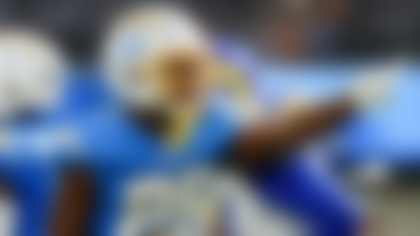NEW ORLEANS -- Improved helmet design has helped reduce concussions in impact sports such as football and hockey, but it might be impossible to design a helmet that completely eliminates them, according to a panel of sports science professors outlining the latest findings.
Helmets "certainly help to mitigate forces that are distributed by impact to the skull and the intracranial cavity and the brain," said Kevin Guskiewicz, a professor of sports science at North Carolina and an expert on football helmets. "But the brain is still going to move inside that cranial cavity regardless of whether there's a helmet on or not."
With improved soft materials inside its hard outer shell, a modern helmet can lessen the effect of a straight-ahead, "linear" impact, but can't do much to prevent the effects of the head rotating from the impact, Guskiewicz said Monday at the National Athletic Trainers' Association convention.
"They do dissipate some of the forces but not to the degree that's required or would be required to manage the energy for preventing concussions," he said.
Guskiewicz and others experts said that "behavior modification" such as discouraging players from "leading with the head" when tackling in football could do as much as improved helmet design to avert concussions.
"I think that behavior modification is perhaps more important in addressing the problem," said Guskiewicz, who credited the NFL's anti-spearing rules as much as safer helmets for reducing football fatalities on all levels from 30 to 35 per year in the mid- to late-1960s to an average of eight from 2008 to 2010.
Improvements in design have made a tremendous difference in preventing disastrous head injuries such as brain bleeds, hematomas and skull fractures.
"These helmets are doing very well at preventing really catastrophic crashes," said Jason Mihalik, an assistant professor of sports science at North Carolina who studies hockey helmets.
And the hits athletes take are serious. Mihalik noted that a crash test dummy traveling at 35 miles per hour absorbs 80 times the force of gravity when it hits a windshield during a crash. Athletes in football, hockey and lacrosse often receive twice that and more when tackled or checked, according to statistics provided by Guskiewicz.
A player starting most of his football games in college will receive 950 to 1,000 "impacts" during a season, according to Guskiewicz. Mihalik said a hockey player takes 300 per year.
Given the number of hits, athletic trainers speaking at the convention urged parents and coaches to wait as long as it takes to heal a concussion to avoid the risk of re-injury. In many cases, it takes weeks for a concussion to heal, with athletes below college age needing the longest recovery periods. Guskiewicz worries that parents eager to see their children return to play after a concussion might harbor illusions about a helmet's effectiveness in order to rush the process along.
"Parents are seeing the advertisements for these concussion-proof helmets. They look for the short and easy way out. Put this special helmet on and that's going to be the answer to preventing the next concussion," said Guskiewicz. "I always tell them, 'Listen, if you're going to send them out there make sure they're wearing a good helmet that fits right for him, that he's comfortable wearing.
"And have some serious conversations with him about how he's loading his head."
Since a perfect helmet has not been designed, tested or manufactured, Mihalik said helmets should be judged by the following criteria: They should fit properly. They should weigh as little as possible. And they should be small, comfortable, economical as well as "look good," he said.
Not all helmets fit that criteria -- and many simply don't fit at all. None of the 18 hockey helmets Mihalik studied fit properly, while seven could be removed without unfastening a single strap. A study subject was even able to move his head inside one hockey helmet while strapped to a spine board.
"The question is are all helmets equal? The short answer is no they are not," Mihalik added.
Still, while not perfect, helmet technology is improving, according to the panelists.
"In 1874, the testicular cup became mandatory in ice hockey. It wasn't until 1974 that the helmet became mandatory. So it only took us 100 years to figure out that head was just as important," said Mihalik. "But hopefully we're going to take this information and help build a better product."
Copyright 2011 by The Associated Press



